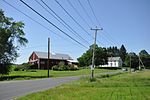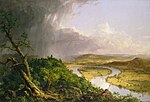Mount Tom, Massachusetts
AC with 0 elementsHampshire County, Massachusetts geography stubsMassachusetts populated places on the Connecticut RiverSpringfield metropolitan area, MassachusettsVillages in Hampshire County, Massachusetts ... and 1 more
Villages in Massachusetts

Mount Tom is a village in the city of Easthampton, Massachusetts, in the United States. It is located in a narrow strip of land between Mount Tom (the mountain) to the south, the Connecticut River to the east, and The Oxbow, an old channel of the Connecticut River, to the north. Interstate 91, U.S. Route 5, and Pan Am Railways' tracks all pass through the village's vicinity as they follow the Connecticut River.
Excerpt from the Wikipedia article Mount Tom, Massachusetts (License: CC BY-SA 3.0, Authors, Images).Mount Tom, Massachusetts
North Street, Easthampton
Geographical coordinates (GPS) Address Nearby Places Show on map
Geographical coordinates (GPS)
| Latitude | Longitude |
|---|---|
| N 42.286111111111 ° | E -72.616111111111 ° |
Address
North Street 19
01063 Easthampton
Massachusetts, United States
Open on Google Maps











